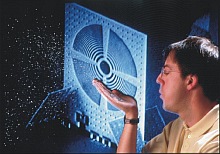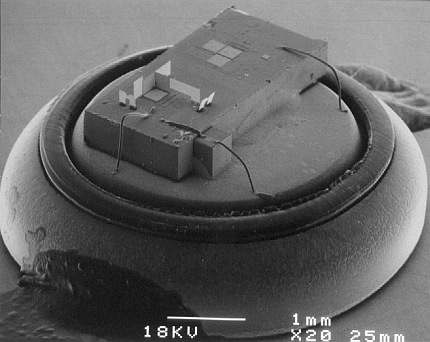Clever dust will go to reconnaissance and fly to Mars
 The article by the American technologist-innovator Ray Kurzweil (Ray Kurzweil) "The Merging of Man with the Machine", excerpts from which you can read in this post darrel 'a, gives a forecast for a very near future in the best traditions of the genre of cyberpunk. The eternal theme of the gradual transformation of man into a semi-cybernetic creature with natural abilities repeatedly enhanced by electronics received a new impetus with the development of the new direction of nanotechnology - the concept of “smart dust” ( English “smart dust”). Let's try to figure out what it is and how it can be used without turning people into cyborgs.
The article by the American technologist-innovator Ray Kurzweil (Ray Kurzweil) "The Merging of Man with the Machine", excerpts from which you can read in this post darrel 'a, gives a forecast for a very near future in the best traditions of the genre of cyberpunk. The eternal theme of the gradual transformation of man into a semi-cybernetic creature with natural abilities repeatedly enhanced by electronics received a new impetus with the development of the new direction of nanotechnology - the concept of “smart dust” ( English “smart dust”). Let's try to figure out what it is and how it can be used without turning people into cyborgs.Actually, the idea of using clouds of microscopic robots in various fields can be called young only with a certain stretch. It has been probed for quite some time in fantastic literature, including in the novel “The Invincible” by Stanislav Lem. Here and in most other works, myriads of working particles of dust with electronic brains act as an aggressive force, successfully destroying tucked people and equipment. Unfortunately, as soon as the level of development allowed mankind to seriously think about creating smart dust, the military first took it up.

One of the current prototypes of the nanorobot dust particles
The most obvious and simple task that can be assigned to the very first, relatively large, pack of nanorobots is the physical destruction of enemy forces with the help of micro explosives. Being dropped from an aircraft (of course, unmanned), the cloud itself automatically searches for targets, splits into clusters of the size necessary for hitting them, clings to them, penetrating unprotected places, and is simultaneously undermined. The resulting volumetric explosion burns the control systems of equipment and devastates the most protected bomb shelters with maximum efficiency inaccessible to conventional weapons.
')
A more peaceful application, for example, reconnaissance of the terrain and espionage, requires much more complex software algorithms and the possibility of using sophisticated means of observation and communication. Therefore, according to experts, it will become feasible with smart dust no earlier than in 7-10 years. The action scenario here is as follows. The cloud sprayed around the important object imperceptibly moves in its direction, simultaneously choosing the optimal places for the placement of specialized sub-clouds. The video surveillance cloud, each speck of dust is a separate pixel of the matrix with a communication interface with neighbors, tends to take a better position for a larger view of the space. Bugs (or, perhaps, "midges") establish control over sounds. The most difficult part, the transfer of information to intelligence headquarters, in the near future is unlikely to be able to do without sending an agent with a device that reads it like in modern RFID systems.
However, all this is still a matter of tomorrow. Fortunately, before smart dust can take part in killing people in uniforms of different colors, there is hope that it will serve for a good purpose. Existing developments today allowed Professor John Barker from the University of Glasgow to propose a detailed plan for using such nanorobots in the study of other planets, in particular Mars. The opportunities opening up for science will very successfully complement those provided by land rovers and, in the long run, UAVs , providing a much more complete picture of the conditions of an alien planet for future manned expeditions.
Among these developments is an effective mechanism for moving dust particles even in difficult atmospheric conditions (strong wind, turbulence). Each speck of dust is enveloped by a polymer film, capable of very quickly and strongly changing its shape under the action of the weakest electric impulses. In the computer model of Barker, a cloud of 50 dust particles freely assumed complex shapes (star, sphere), hovering in the air or moving in an organized direction in the right direction.
However, there are smart dust applications that can be implemented today. Construction companies in the near future will begin to use the simplest robots to monitor the state of reinforced concrete structures. To do this, a small number of robots are added to the concrete solution, having a gyroscope on board and an associated device for calculating the difference between the current and initial coordinates. Thanks to this, the monitoring services will be able to literally take the necessary data from the ceiling if they need to figure out how different loads act on it.
Source: https://habr.com/ru/post/7202/
All Articles